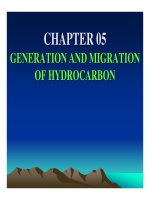ĐỊA CHẤT DẦU KHÍ ( PETROLEUM GEOLOGY ) - CHƯƠNG 2 docx
Bạn đang xem bản rút gọn của tài liệu. Xem và tải ngay bản đầy đủ của tài liệu tại đây (5.47 MB, 94 trang )
CHAPTER 02
CHAPTER 02
RESERVOIR
RESERVOIR
INTRODUCTION
INTRODUCTION
CONDITION FOR AN ACCUMULATION OF
CONDITION FOR AN ACCUMULATION OF
OIL AND GAS
OIL AND GAS
° A mature source rock
° A reservoir rock
° A migration route (betw. Source & Res.)
° An impermeable seal
° A trap
RESERVOIR
RESERVOIR
° A single continuous deposit of gas and/or oil in
the pores of a reservoir rock. A reservoir has a
single pressure system and don’t communicate
with other reservoirs.
° The portion of the trap that contains petroleum,
including the reservoir rock, pores, and fluids.
° A pond, lake or environment that is used store
liquids.
Exp: RESERVOIR
Exp: RESERVOIR
OF CUU LONG
OF CUU LONG
AND SOUTHERN
AND SOUTHERN
CONSON BASINS
CONSON BASINS
Figure 1
RESERVOIR (cont.)
RESERVOIR (cont.)
° There are two fundamental physical properties
that a good reservoir must have:
+ Porosity or sufficient void space contain
significant petroleum.
+ Permeability, the ability of petroleum to
flow into, or out of these voids.
° The only common rock type that have
favorable combination of porosity and
permeability to be reservoirs are sandstones
and carbonates.
POROSITY
POROSITY
° Porosity is the percentage of volume of voids
to the total volume of rock. It has the symbol
: 0 ≤ ≤ 1
° Effective porosity: the amount of internal
space or voids that is interconnected, and so
able to transmit fluids.
° Non-effective porosity: isolated pores and
pores volume occupied by adsorbed water.
Figure 2:
Figure 2:
The frequency of oil and gas reservoirs plotted against porosity
The frequency of oil and gas reservoirs plotted against porosity
.
.
Almost all
Almost all
reservoirs have
reservoirs have
porosities in a
porosities in a
range of five to
range of five to
thirty percent
thirty percent
with the majority
with the majority
falling between
falling between
ten and twenty
ten and twenty
percent.
percent.
POROSITY (cont.)
POROSITY (cont.)
° There are three main types of porosity:
+ Interconnected porosity has multiple pore
throat passages to connect neighboring pore.
+ Connected porosity has only one pore throat
passages connecting with another pore space.
+ Isolated porosity has no connection between
pore.
° Interconnected and connected pore contribute
effective porosity because hydrocarbon can
move out from them.
Interconnected porosity
Interconnected porosity
Connected porosity
Isolated porosity
CLASSIFIED POROSITY
CLASSIFIED POROSITY
° Porosity can be classified into two major types
according to their origin:
Primary porosity
Intergranular, or interparticle porosity with
occurs between grains of sediment.
Intragranular, or intraparticle porosity which
actually occurs within the sediment grains
themselves.
Second porosity
Fenestral
Intercrystalline
Solution (moldic and vuggy)
Fracture
Primary Porosity
• Primary porosity is divisible into two types:
intergranular or interparticle porosity, which
occurs between the grains of a sediment (
Figure 1 ) and intragranular or intraparticle
porosity,
Intergranular
Intergranular
porosity
porosity
intragranular
intragranular
porosity
porosity
Secondary Porosity
Secondary Porosity
Secondary porosity is porosity formed within a
reservoir after deposition. The major types of
secondary porosity are:
• Fenestral;
• Intercrystalline;
• Solution (moldic and vuggy);
• Fracture.
Fenestral porosity
Fenestral porosity
is developed where there is a gap in
is developed where there is a gap in
the rock framework larger than the normal grain
the rock framework larger than the normal grain
-
-
supported pore spaces.
supported pore spaces.
Fenestral porosity is characteristic of lagoonal
Fenestral porosity is characteristic of lagoonal
pelmicrites in which dehydration has caused shrinkage
pelmicrites in which dehydration has caused shrinkage
and buckling of the laminae. This type of porosity is
and buckling of the laminae. This type of porosity is
less frequently encountered.
less frequently encountered.
Crystalline dolomite reservoir: reservoirs are usually
composed of secondary dolomite formed by
"dolomitization", the process whereby a pre-existing
calcium carbonate deposit is replaced by dolomite.
Figure 1:
Figure 1:
A sketch of a thin section of a
A sketch of a thin section of a
crystalline dolomite
crystalline dolomite
Several types of secondary porosity can be caused by
Several types of secondary porosity can be caused by
solution
solution
.
.
Fracture porosity
Fracture porosity
• Fractured reservoirs can occur in any brittle rock that
breaks by fracturing rather than by plastic
deformation. Thus, there are fractured reservoirs in
shales, hard-cemented quartzitic sandstones,
limestones, dolomites and, of course, basement rocks
such as granites and metamorphics.
• In Figure 3, fractures may develop from tectonic
forces associated with folding and faulting.
Figure 3
Figure 3
• They may also develop from overburden
unloading and weathering immediately under
unconformities. Shrinkage from cooling of
igneous rocks and dehydrating of shales also
causes fracturing.
• Fractures are generally vertical to subvertical
with widths varying from paper thin to about 6
mm
porosity and porosity which occurs within the rock
itself. Very often fractures are an important part of
storage capacity, and sometimes only oil or gas from
the fracture pore space itself is actually produced.
• Fracture porosity can result in high production rates
during initial testing of a well, followed by a rapid
decline in production thereafter. When a rock has
been fractured, the fractures do not necessarily
remain open. They may be infilled by later
cementation by silica, calcite or dolomite









